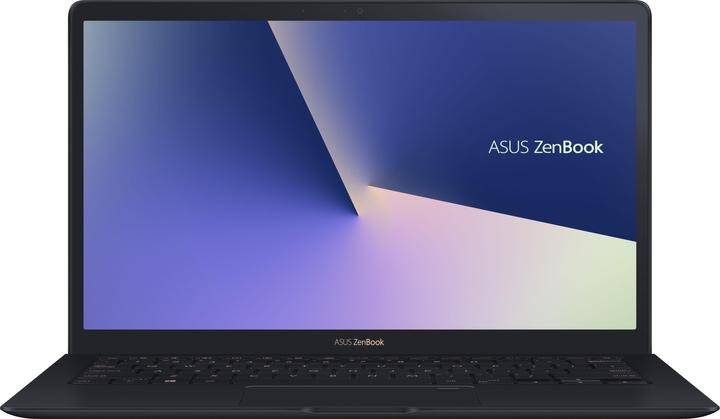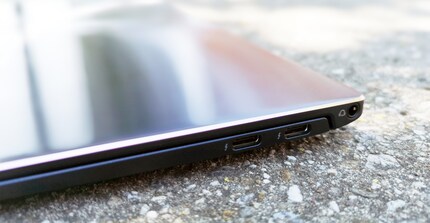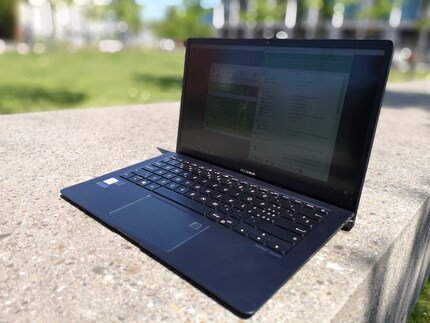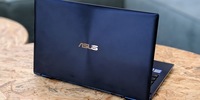

Asus Zen Book S: Mobility and design come at a price
The Asus Zen Book S (UX391UA) is aimed at business and home office users with high demands. Read our test report to find out what the notebook is capable of.
The design of the Zen Book S is simple, but I am completely convinced by it. As a record fan, the grooves in the aluminium evoke nostalgic feelings in me. The gold lettering and gold-plated edges give the device a classy look. When I open the device, the rear part of the base rises by a few centimetres. Asus calls this the Ergo-Lift hinge. This makes the notebook an eye-catcher even when unfolded and, according to Asus, should ensure better cooling.

Asus focusses on mobility with the Zen Book S. The device weighs just over one kilogramme. Despite all the mobility, performance should not be neglected. In addition to the Intel Core i7-8550U, 16 GB of RAM is installed. However, a dedicated graphics card has been omitted. This is probably due to the thin design and the resulting lack of space. Asus relies on the Intel UHD Graphics 620.

Most important specs in brief:
- CPU: Intel Core i7-8550U
- GPU: Intel UHD Graphics 620
- Memory: Two times 8 GB PC34100U
- Mass storage: 512 GB Samsung NVMe
- Display: 13.3 inch Full HD IPS display (anti-glare)
Ports

Like most manufacturers, Asus saves on the physical interfaces. This is due to the low height. Three USB-C ports are installed. The port on the left corresponds to the Gen 1 standard. Two further ports are located on the right-hand side. These are fully-fledged Thunderbolt 3 interfaces. A 3.5 mm jack plug is located next to it. Asus also supplies a mini dock, which provides additional connections such as HDMI and USB-A. For wireless communication, Asus relies on the Intel Dual Band Wireless-AC 8265 adapter, which offers Bluetooth 4.2 in addition to the 802.11ac Wi-Fi standard
Display
Subjectively, I really like the display. Although it is matt, the image does not appear grainy. With an average brightness of 300 cd/m², it is not particularly bright. However, thanks to the anti-reflective coating, I can work better with it in sunlight than I can gaming with the Nintendo Switch.

The image is always clear and recognisable, even from the side. The colours look natural, only losing some of their brightness in the corners.
Speakers
As in all newer Asus notebooks, the Zen Book S is equipped with Harman/Kardon stereo speakers. These are located on the underside of the base. The quality of the music playback is clear and crisp. The bass is rich and there is no rattling at all. A pleasant side effect: the bass vibration can be felt when typing, as the speakers are located just below the palm of the hand. I was somewhat disappointed with the reproduction of films. During action scenes, the speakers rattled a little, which somewhat spoilt the good overall impression.
Battery
The notebook shines above all with its mobility. The built-in 50 Wh battery works wonders in the Heavy Load stress test. I was able to run it for almost two hours on battery power before the battery gave up. The CPU, GPU, RAM and mass storage are constantly utilised during testing. In normal office use, the battery lasts for around eight hours.
Keyboard and touchpad
Thanks to the Ergo-Lift hinge, typing on the Zen Book S is very comfortable. The keyboard offers enough grip and the key travel is short. Typing requires a little more pressure than I'm used to from other keyboards, but I don't find this annoying. The only thing that bothers me is the Asus-typical compressed Enter key. I often miss it and press the dollar key.
The trackpad seems a little small at first glance, but it's easy to work with. Its width in particular is perfectly matched to the keyboard. Although I come close to the trackpad when typing, I never press it unintentionally. It responds very reliably. Only the top area at the height of the fingerprint scanner is not pressure-sensitive. Scanning also works flawlessly.
CPU and GPU
On paper, the i7-8550U is a fast notebook processor at the time of testing. I achieved a score of around 350 in Cinebench R15 in several tests, which puts the i7-8550U in the Asus Zen Book S around 200 points below the average for this type of processor. This may be due to the cooling, which is probably not optimal in the thin Zen Book.

The integrated GPU is not expected to deliver top performance. When rendering with OpenGL, the GPU achieves around 40 fps. This puts the UHD 620 in the lower range of comparable GPUs.
Mass memory

A Samsung SSD PM961 in m.2 form factor with 512 GB is installed, which is connected via PCIe x4. According to the manufacturer, it achieves sequential read speeds of around 2800 MB/s and sequential write speeds of around 1600 MB/s. In my tests, I achieved similar values, making the SSD one of the fastest currently available.
Fan
In normal use, the fan is very quiet and I have to listen very carefully to hear it at all. If the Zen Book S is put under a bit of stress, the picture is different. The fan becomes very loud. It can also get hot in the upper area of the base. Despite the Ergo-Lift hinge, the cooling is not optimal, as the performance tests of the CPU and GPU have already shown.
Conclusion
The Zen Book S is primarily designed for mobility and office use. If you are not too demanding, you can even complete smaller multimedia tasks. The generous 16 GB RAM helps here. However, the notebook quickly reaches its limits when it comes to graphics-intensive tasks. The Zen Book S has to compromise on performance due to its compact design.
Where the notebook falls short in terms of performance, it shows its strengths in terms of mobility. The low weight, high-quality workmanship and long-lasting battery make the Zen Book S the ideal companion for travelling. It also impresses with its look.
The great looks come at a price. Over 1800 francs is a proud price for the device. I would have liked more performance for all that money. But it comes at a price: mobility comes at the expense of performance.
From big data to big brother, Cyborgs to Sci-Fi. All aspects of technology and society fascinate me.


